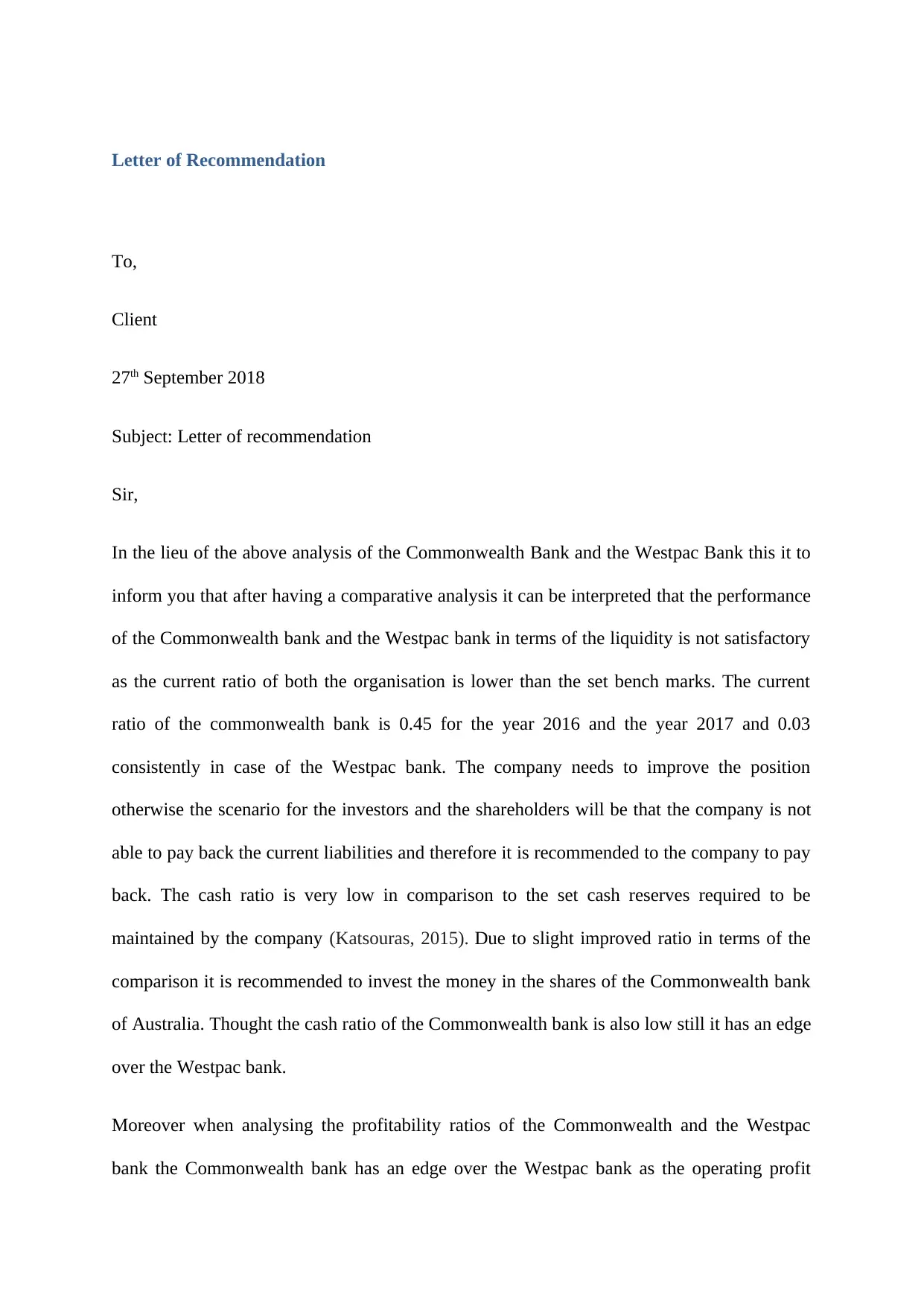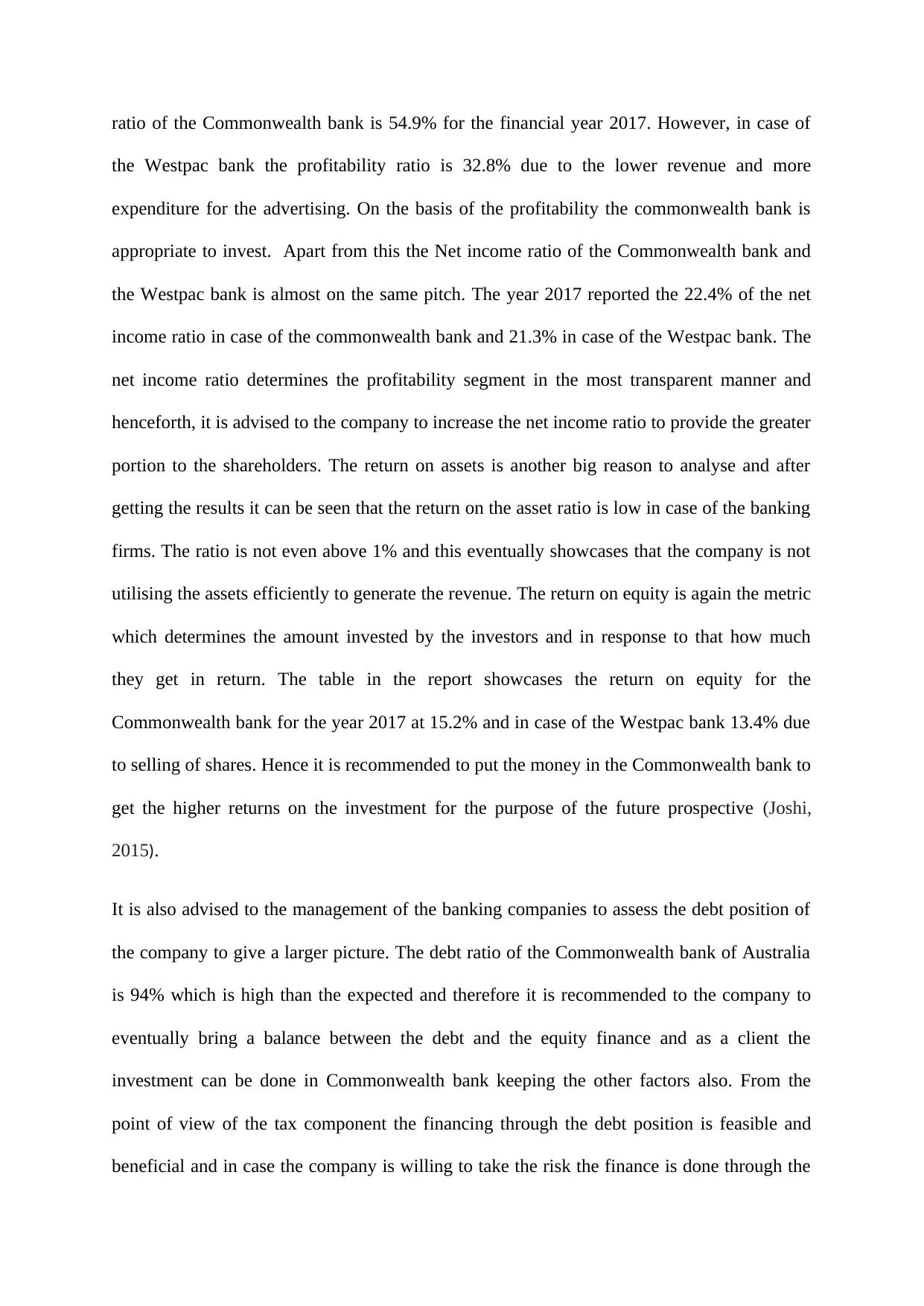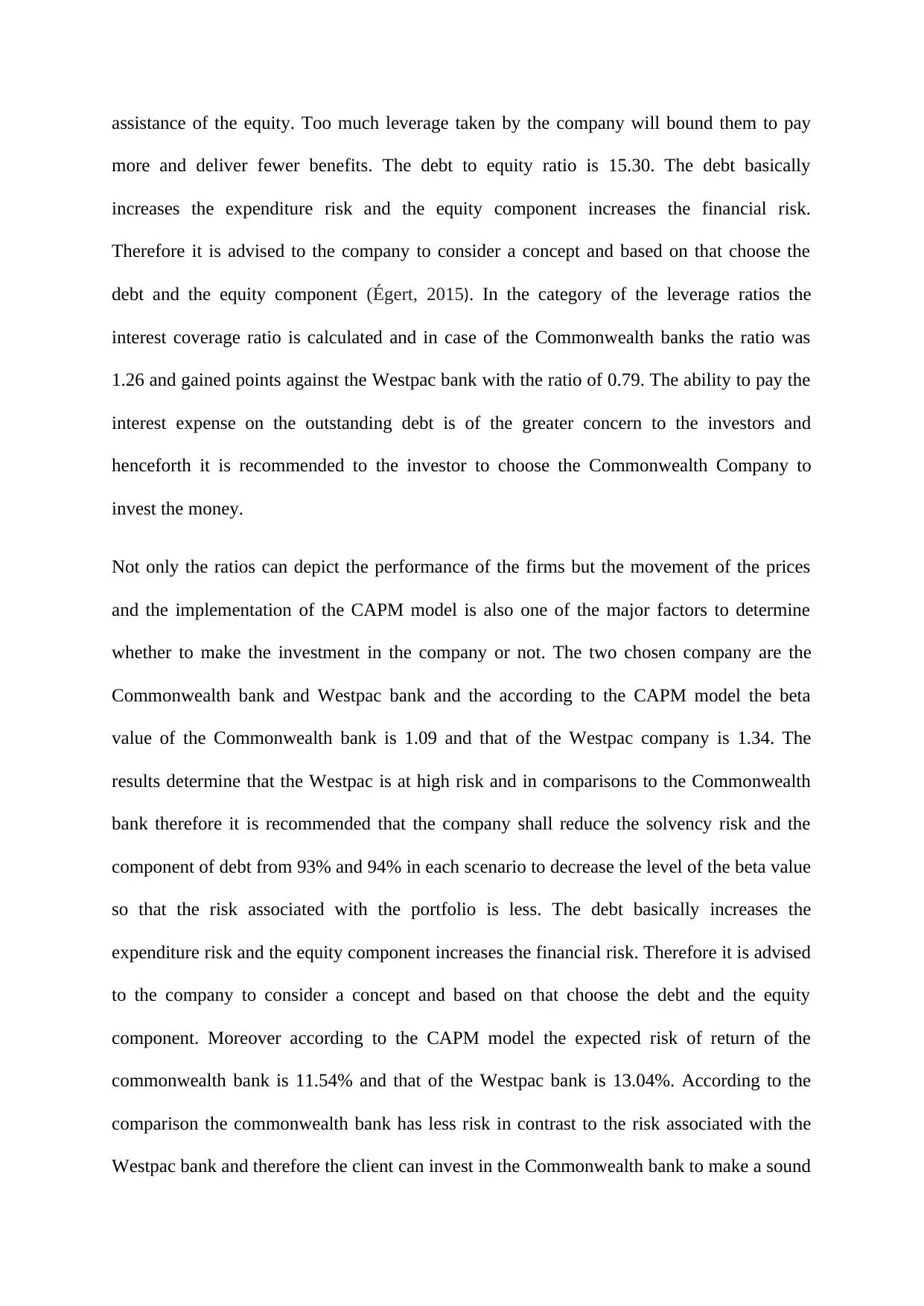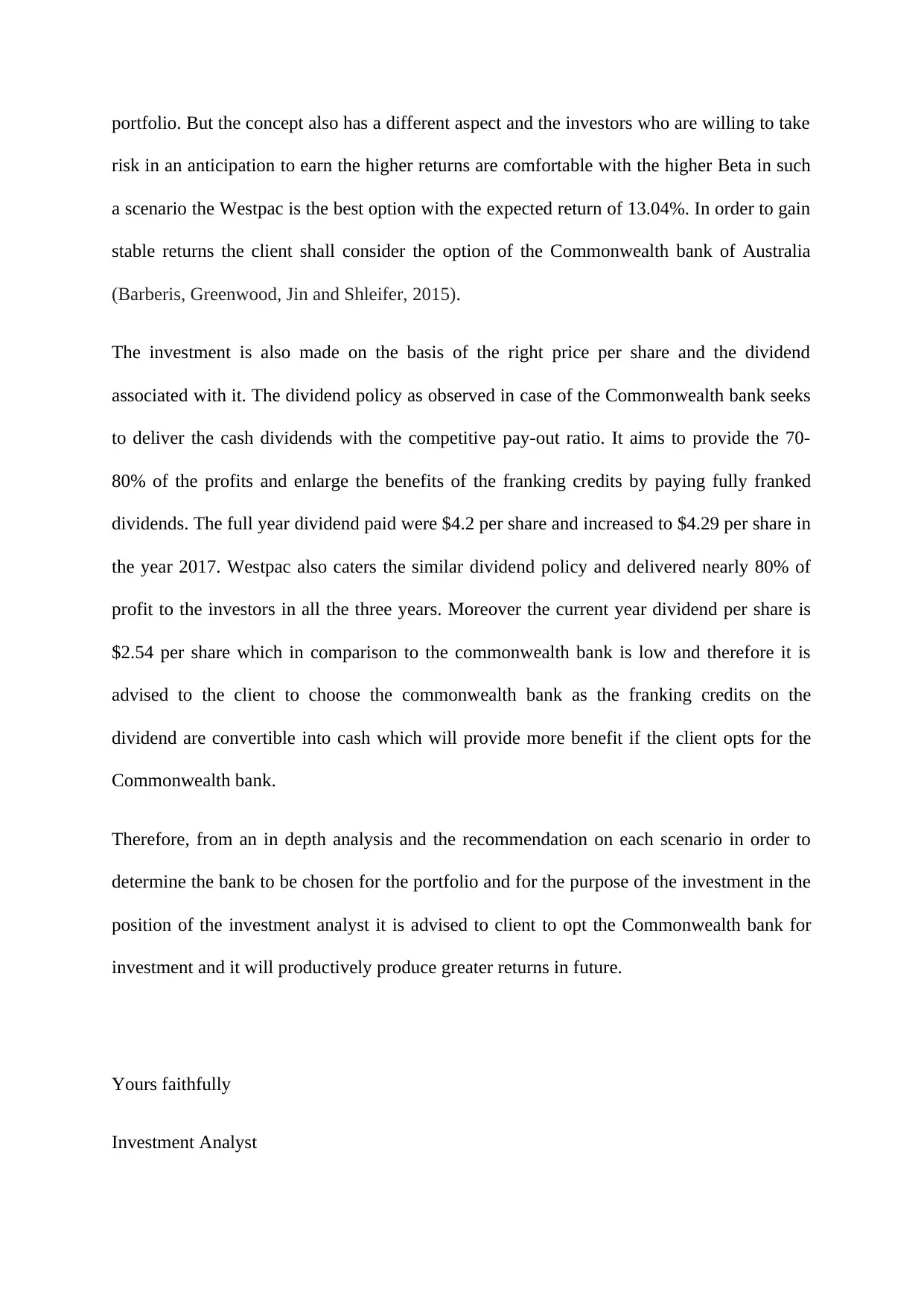Financial Performance Analysis: Commonwealth Bank and Westpac Banks
VerifiedAdded on 2023/06/03
|7
|1518
|377
Report
AI Summary
This report provides a comparative financial analysis of the Commonwealth Bank of Australia and Westpac Bank, evaluating their performance based on key financial ratios and models. The analysis covers liquidity, profitability, and leverage ratios, highlighting the current and cash ratios, operating profit ratios, and return on assets and equity. The report also incorporates the Capital Asset Pricing Model (CAPM) to assess risk and return, providing investment recommendations based on the financial data and market analysis. The study suggests that, while both banks have strengths, the Commonwealth Bank presents a more favorable investment opportunity due to its profitability and lower risk profile. The report also discusses dividend policies and provides an in-depth view of the banks' financial health, offering insights for potential investors.

Letter of Recommendation
Paraphrase This Document
Need a fresh take? Get an instant paraphrase of this document with our AI Paraphraser

Letter of Recommendation
To,
Client
27th September 2018
Subject: Letter of recommendation
Sir,
In the lieu of the above analysis of the Commonwealth Bank and the Westpac Bank this it to
inform you that after having a comparative analysis it can be interpreted that the performance
of the Commonwealth bank and the Westpac bank in terms of the liquidity is not satisfactory
as the current ratio of both the organisation is lower than the set bench marks. The current
ratio of the commonwealth bank is 0.45 for the year 2016 and the year 2017 and 0.03
consistently in case of the Westpac bank. The company needs to improve the position
otherwise the scenario for the investors and the shareholders will be that the company is not
able to pay back the current liabilities and therefore it is recommended to the company to pay
back. The cash ratio is very low in comparison to the set cash reserves required to be
maintained by the company (Katsouras, 2015). Due to slight improved ratio in terms of the
comparison it is recommended to invest the money in the shares of the Commonwealth bank
of Australia. Thought the cash ratio of the Commonwealth bank is also low still it has an edge
over the Westpac bank.
Moreover when analysing the profitability ratios of the Commonwealth and the Westpac
bank the Commonwealth bank has an edge over the Westpac bank as the operating profit
To,
Client
27th September 2018
Subject: Letter of recommendation
Sir,
In the lieu of the above analysis of the Commonwealth Bank and the Westpac Bank this it to
inform you that after having a comparative analysis it can be interpreted that the performance
of the Commonwealth bank and the Westpac bank in terms of the liquidity is not satisfactory
as the current ratio of both the organisation is lower than the set bench marks. The current
ratio of the commonwealth bank is 0.45 for the year 2016 and the year 2017 and 0.03
consistently in case of the Westpac bank. The company needs to improve the position
otherwise the scenario for the investors and the shareholders will be that the company is not
able to pay back the current liabilities and therefore it is recommended to the company to pay
back. The cash ratio is very low in comparison to the set cash reserves required to be
maintained by the company (Katsouras, 2015). Due to slight improved ratio in terms of the
comparison it is recommended to invest the money in the shares of the Commonwealth bank
of Australia. Thought the cash ratio of the Commonwealth bank is also low still it has an edge
over the Westpac bank.
Moreover when analysing the profitability ratios of the Commonwealth and the Westpac
bank the Commonwealth bank has an edge over the Westpac bank as the operating profit

ratio of the Commonwealth bank is 54.9% for the financial year 2017. However, in case of
the Westpac bank the profitability ratio is 32.8% due to the lower revenue and more
expenditure for the advertising. On the basis of the profitability the commonwealth bank is
appropriate to invest. Apart from this the Net income ratio of the Commonwealth bank and
the Westpac bank is almost on the same pitch. The year 2017 reported the 22.4% of the net
income ratio in case of the commonwealth bank and 21.3% in case of the Westpac bank. The
net income ratio determines the profitability segment in the most transparent manner and
henceforth, it is advised to the company to increase the net income ratio to provide the greater
portion to the shareholders. The return on assets is another big reason to analyse and after
getting the results it can be seen that the return on the asset ratio is low in case of the banking
firms. The ratio is not even above 1% and this eventually showcases that the company is not
utilising the assets efficiently to generate the revenue. The return on equity is again the metric
which determines the amount invested by the investors and in response to that how much
they get in return. The table in the report showcases the return on equity for the
Commonwealth bank for the year 2017 at 15.2% and in case of the Westpac bank 13.4% due
to selling of shares. Hence it is recommended to put the money in the Commonwealth bank to
get the higher returns on the investment for the purpose of the future prospective (Joshi,
2015).
It is also advised to the management of the banking companies to assess the debt position of
the company to give a larger picture. The debt ratio of the Commonwealth bank of Australia
is 94% which is high than the expected and therefore it is recommended to the company to
eventually bring a balance between the debt and the equity finance and as a client the
investment can be done in Commonwealth bank keeping the other factors also. From the
point of view of the tax component the financing through the debt position is feasible and
beneficial and in case the company is willing to take the risk the finance is done through the
the Westpac bank the profitability ratio is 32.8% due to the lower revenue and more
expenditure for the advertising. On the basis of the profitability the commonwealth bank is
appropriate to invest. Apart from this the Net income ratio of the Commonwealth bank and
the Westpac bank is almost on the same pitch. The year 2017 reported the 22.4% of the net
income ratio in case of the commonwealth bank and 21.3% in case of the Westpac bank. The
net income ratio determines the profitability segment in the most transparent manner and
henceforth, it is advised to the company to increase the net income ratio to provide the greater
portion to the shareholders. The return on assets is another big reason to analyse and after
getting the results it can be seen that the return on the asset ratio is low in case of the banking
firms. The ratio is not even above 1% and this eventually showcases that the company is not
utilising the assets efficiently to generate the revenue. The return on equity is again the metric
which determines the amount invested by the investors and in response to that how much
they get in return. The table in the report showcases the return on equity for the
Commonwealth bank for the year 2017 at 15.2% and in case of the Westpac bank 13.4% due
to selling of shares. Hence it is recommended to put the money in the Commonwealth bank to
get the higher returns on the investment for the purpose of the future prospective (Joshi,
2015).
It is also advised to the management of the banking companies to assess the debt position of
the company to give a larger picture. The debt ratio of the Commonwealth bank of Australia
is 94% which is high than the expected and therefore it is recommended to the company to
eventually bring a balance between the debt and the equity finance and as a client the
investment can be done in Commonwealth bank keeping the other factors also. From the
point of view of the tax component the financing through the debt position is feasible and
beneficial and in case the company is willing to take the risk the finance is done through the
⊘ This is a preview!⊘
Do you want full access?
Subscribe today to unlock all pages.

Trusted by 1+ million students worldwide

assistance of the equity. Too much leverage taken by the company will bound them to pay
more and deliver fewer benefits. The debt to equity ratio is 15.30. The debt basically
increases the expenditure risk and the equity component increases the financial risk.
Therefore it is advised to the company to consider a concept and based on that choose the
debt and the equity component (Égert, 2015). In the category of the leverage ratios the
interest coverage ratio is calculated and in case of the Commonwealth banks the ratio was
1.26 and gained points against the Westpac bank with the ratio of 0.79. The ability to pay the
interest expense on the outstanding debt is of the greater concern to the investors and
henceforth it is recommended to the investor to choose the Commonwealth Company to
invest the money.
Not only the ratios can depict the performance of the firms but the movement of the prices
and the implementation of the CAPM model is also one of the major factors to determine
whether to make the investment in the company or not. The two chosen company are the
Commonwealth bank and Westpac bank and the according to the CAPM model the beta
value of the Commonwealth bank is 1.09 and that of the Westpac company is 1.34. The
results determine that the Westpac is at high risk and in comparisons to the Commonwealth
bank therefore it is recommended that the company shall reduce the solvency risk and the
component of debt from 93% and 94% in each scenario to decrease the level of the beta value
so that the risk associated with the portfolio is less. The debt basically increases the
expenditure risk and the equity component increases the financial risk. Therefore it is advised
to the company to consider a concept and based on that choose the debt and the equity
component. Moreover according to the CAPM model the expected risk of return of the
commonwealth bank is 11.54% and that of the Westpac bank is 13.04%. According to the
comparison the commonwealth bank has less risk in contrast to the risk associated with the
Westpac bank and therefore the client can invest in the Commonwealth bank to make a sound
more and deliver fewer benefits. The debt to equity ratio is 15.30. The debt basically
increases the expenditure risk and the equity component increases the financial risk.
Therefore it is advised to the company to consider a concept and based on that choose the
debt and the equity component (Égert, 2015). In the category of the leverage ratios the
interest coverage ratio is calculated and in case of the Commonwealth banks the ratio was
1.26 and gained points against the Westpac bank with the ratio of 0.79. The ability to pay the
interest expense on the outstanding debt is of the greater concern to the investors and
henceforth it is recommended to the investor to choose the Commonwealth Company to
invest the money.
Not only the ratios can depict the performance of the firms but the movement of the prices
and the implementation of the CAPM model is also one of the major factors to determine
whether to make the investment in the company or not. The two chosen company are the
Commonwealth bank and Westpac bank and the according to the CAPM model the beta
value of the Commonwealth bank is 1.09 and that of the Westpac company is 1.34. The
results determine that the Westpac is at high risk and in comparisons to the Commonwealth
bank therefore it is recommended that the company shall reduce the solvency risk and the
component of debt from 93% and 94% in each scenario to decrease the level of the beta value
so that the risk associated with the portfolio is less. The debt basically increases the
expenditure risk and the equity component increases the financial risk. Therefore it is advised
to the company to consider a concept and based on that choose the debt and the equity
component. Moreover according to the CAPM model the expected risk of return of the
commonwealth bank is 11.54% and that of the Westpac bank is 13.04%. According to the
comparison the commonwealth bank has less risk in contrast to the risk associated with the
Westpac bank and therefore the client can invest in the Commonwealth bank to make a sound
Paraphrase This Document
Need a fresh take? Get an instant paraphrase of this document with our AI Paraphraser

portfolio. But the concept also has a different aspect and the investors who are willing to take
risk in an anticipation to earn the higher returns are comfortable with the higher Beta in such
a scenario the Westpac is the best option with the expected return of 13.04%. In order to gain
stable returns the client shall consider the option of the Commonwealth bank of Australia
(Barberis, Greenwood, Jin and Shleifer, 2015).
The investment is also made on the basis of the right price per share and the dividend
associated with it. The dividend policy as observed in case of the Commonwealth bank seeks
to deliver the cash dividends with the competitive pay-out ratio. It aims to provide the 70-
80% of the profits and enlarge the benefits of the franking credits by paying fully franked
dividends. The full year dividend paid were $4.2 per share and increased to $4.29 per share in
the year 2017. Westpac also caters the similar dividend policy and delivered nearly 80% of
profit to the investors in all the three years. Moreover the current year dividend per share is
$2.54 per share which in comparison to the commonwealth bank is low and therefore it is
advised to the client to choose the commonwealth bank as the franking credits on the
dividend are convertible into cash which will provide more benefit if the client opts for the
Commonwealth bank.
Therefore, from an in depth analysis and the recommendation on each scenario in order to
determine the bank to be chosen for the portfolio and for the purpose of the investment in the
position of the investment analyst it is advised to client to opt the Commonwealth bank for
investment and it will productively produce greater returns in future.
Yours faithfully
Investment Analyst
risk in an anticipation to earn the higher returns are comfortable with the higher Beta in such
a scenario the Westpac is the best option with the expected return of 13.04%. In order to gain
stable returns the client shall consider the option of the Commonwealth bank of Australia
(Barberis, Greenwood, Jin and Shleifer, 2015).
The investment is also made on the basis of the right price per share and the dividend
associated with it. The dividend policy as observed in case of the Commonwealth bank seeks
to deliver the cash dividends with the competitive pay-out ratio. It aims to provide the 70-
80% of the profits and enlarge the benefits of the franking credits by paying fully franked
dividends. The full year dividend paid were $4.2 per share and increased to $4.29 per share in
the year 2017. Westpac also caters the similar dividend policy and delivered nearly 80% of
profit to the investors in all the three years. Moreover the current year dividend per share is
$2.54 per share which in comparison to the commonwealth bank is low and therefore it is
advised to the client to choose the commonwealth bank as the franking credits on the
dividend are convertible into cash which will provide more benefit if the client opts for the
Commonwealth bank.
Therefore, from an in depth analysis and the recommendation on each scenario in order to
determine the bank to be chosen for the portfolio and for the purpose of the investment in the
position of the investment analyst it is advised to client to opt the Commonwealth bank for
investment and it will productively produce greater returns in future.
Yours faithfully
Investment Analyst

⊘ This is a preview!⊘
Do you want full access?
Subscribe today to unlock all pages.

Trusted by 1+ million students worldwide

References
Barberis, N., Greenwood, R., Jin, L. and Shleifer, A., (2015) X-CAPM: An extrapolative
capital asset pricing model. Journal of financial economics, 115(1), pp.1-24.
Égert, B., (2015) Public debt, economic growth and nonlinear effects: Myth or
reality?. Journal of Macroeconomics, 43, pp.226-238.
Joshi, M., (2015) Divergence between Operating Profit and EBIT. New York: Springer
Katsouras, I., Zhao, D., Spijkman, M.J., Li, M., Blom, P.W., De Leeuw, D.M. and Asadi, K.,
(2015) Controlling the on/off current ratio of ferroelectric field-effect transistors. Scientific
reports, 5, p.12094.
Barberis, N., Greenwood, R., Jin, L. and Shleifer, A., (2015) X-CAPM: An extrapolative
capital asset pricing model. Journal of financial economics, 115(1), pp.1-24.
Égert, B., (2015) Public debt, economic growth and nonlinear effects: Myth or
reality?. Journal of Macroeconomics, 43, pp.226-238.
Joshi, M., (2015) Divergence between Operating Profit and EBIT. New York: Springer
Katsouras, I., Zhao, D., Spijkman, M.J., Li, M., Blom, P.W., De Leeuw, D.M. and Asadi, K.,
(2015) Controlling the on/off current ratio of ferroelectric field-effect transistors. Scientific
reports, 5, p.12094.
1 out of 7
Related Documents
Your All-in-One AI-Powered Toolkit for Academic Success.
+13062052269
info@desklib.com
Available 24*7 on WhatsApp / Email
![[object Object]](/_next/static/media/star-bottom.7253800d.svg)
Unlock your academic potential
Copyright © 2020–2025 A2Z Services. All Rights Reserved. Developed and managed by ZUCOL.





